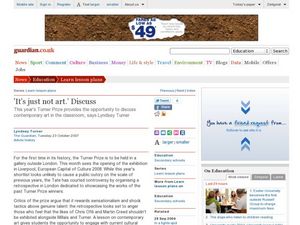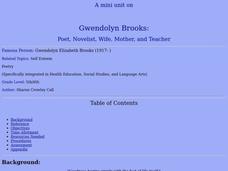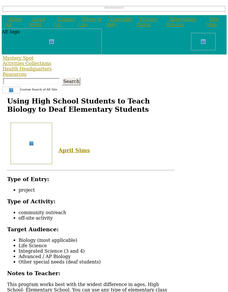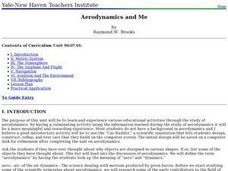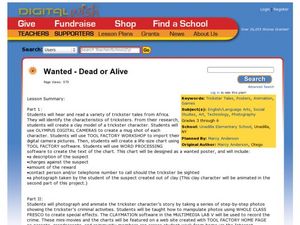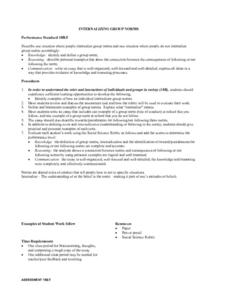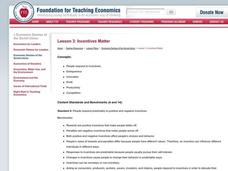Curated OER
A Nobel Cause
Students research the lives and accomplishments of Nobel Prize-winning scientists and compose stories about what the world would be like without the accomplishments of these scientists.
Curated OER
Checkmate
Students start identifying the cause and effect relationships in games of Chess. Using the internet, they research the history of the game and how the roles for each of the pieces. They develop a skit based on the roles and...
Curated OER
Backwards Day
Students create ways to do things backwards. For this cross-curriculum lesson, students participate in various backwards activities for an entire day. Students recite the alphabet backwards, spell their names backwards, and read stories...
Curated OER
It's Just Not Art
High schoolers examine multiple styles of artwork that have earned awards. In this art lesson, students discuss the definition of contemporary art then compare how artwork has changed over the years.
Curated OER
How Do Artists Get Their Ideas? Culture and Environment as Sources of Ideas
Students share the difficulties they have in determining what to write or draw for a project. In groups, they view examples from three different artists and discuss how their personal experiences affected their art. They brainstorm a...
Curated OER
Gwendolyn Brooks
Students examine the contributions of the author Gwendolyn Brooks. They create a journal, read and discuss poems by Brooks, write a poem about themselves, and create a timeline of their own lives.
Curated OER
Order of Operations
Students analyze the Order of Operations. They play a game to explore Order of Operations and observe a PowerPoint presentation slide sow. They generate patterns and functions to represent and solve problems. Students model and solve...
Curated OER
Women in Progressive Era
Learners study the Progressive Era. They identify the important people, places, and evens of the Era and determine how women influenced the progressive movement. In addition, they create an article to address issues related to the movement.
Curated OER
Lesson 12: Ho'olaulima: Let's Make a Hawaiian Garden
Second graders grow a classroom garden that acts as a living laboratory for cross-curricular activities. In this classroom garden lesson, 2nd graders follow directions to build and plant a garden that is used to teach math, science, and...
Curated OER
Using High School Students to Teach Biology to Deaf Elementary Students
Students teach Biology concepts to elementary students, in particular deaf students, by traveling once a month to the elementary classroom with activities / lessons that have been selected and prepared by the older students.
Curated OER
What a Garden Can Teach Us
Third graders read "Seedfolks" and "What a Garden Can Teach Us" and discuss how a garden is like a community. They create a class quilt illustrating how their classroom community the lines of the poem.
Curated OER
African American Poetry: Family and Traditions
Learners are introduced to the elements of African-American poetry. As a class, they are read different types of poems to discover there are different styles of poems and practice rhyming words. They share information on their family...
Curated OER
Aerodynamics And Me
Seventh graders design, construct, refine, and test cars that they build on the computer screen. They find the density of several objects using the techniques used to find volume. They measure various common objects to become more...
Curated OER
The Talking Goat Lesson
Students analyze the meanings and patterns of a folk tale. They respond in their reading journals to the following prompts: How do you feel about the way "The Talking Goat" ended? Why? Which did you like better: your group's predicted...
Curated OER
The Season of Spring
Young scholars perform a story from Greek mythology of how spring came to be. In this performing arts lesson, students study the play of Persephone and use instruments and dance to put on a performance.
Curated OER
Wanted- Dead or Alive
Students identify the characteristics of trickster tales. In this literary genres lesson, students read trickster tales from Africa and create a clay model of a trickster character. Students design a "wanted" poster with a...
Curated OER
Life Cycle- The Human Body
Seventh graders examine the life cycle of the human. In this human life cycle instructional activity, 7th graders discuss the many different stages of the human life cycle. Students use pictures from magazines to create a representation...
Curated OER
Populism and the People’s Party
Students examine the history of the Populist Party as it relates to its reforms and economic plight. In this Populism and the People's Party lesson plan, students explore why farmers experienced financial difficulty at the end of the...
Curated OER
Urban Life: What Lives in Our Schoolyard?
Students research living organisms by exploring their school grounds. In this microscopic observation lesson, students gather materials, insects, and objects from their playground and schoolyard and bring them into class. Students...
Curated OER
Images of Science
Students discover that science is part of everyday life. In this science lesson, students create a science collage, draw a scientist, and write about science in the news.
Curated OER
Workplace Vocabulary
High schoolers engage in daily spelling and vocabulary practice of workplace-related terms with definition matching exercises, word scrambles, dictation, sentence writing. Finally, they compose a short essay in which they use the words...
Curated OER
Electrophoresis Analogy
Students participate in a simulation of electrophoresis separation of DNA fragments. They link arms to form DNA fragments with each student representing a nucleotide. As they move through an obstacle course they discover how fragments...
Curated OER
Internalizing Group Norms
Young scholars consider how to internalize group norms. They descirbe a situation where people internalize group norms and a situation where people do not internalize group norms. They brainstorm examples of group norms and define...
Curated OER
Incentives Matter
Middle schoolers identify what motive people. They will learn about both positive, and negative incentives. They will use this knowledge to make predictions about how people will behave. They will apply this knowledge to economics.



